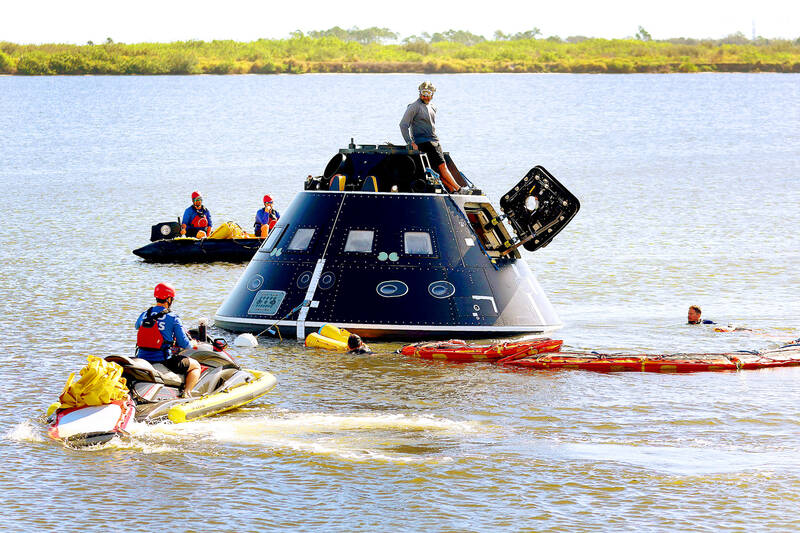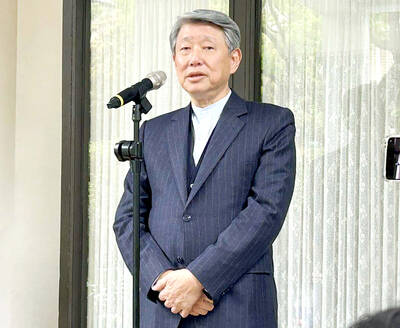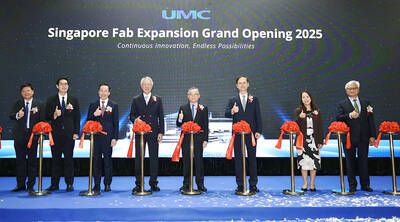For years, NASA has been planting the seeds of what it hopes will one day sprout into a full-fledged lunar economy. Private companies could ferry people and cargo to and from the moon, creating a base to conduct science and, eventually, mine resources and even lunar ice as an ingredient to make rocket propellant.
It is a grand vision that could start to take shape this year and eventually lead to a marketplace in which companies could use the lunar environment to turn a profit as they do with orbiting satellites.
Much would have to go right for that future to coalesce over the next decade or so, starting with making trips to and from the moon as routine as satellite launches.

Photo: AFP
For now, the lunar economy consists mainly of money from NASA contracts, and it is likely to stay that way well into the decade. If a self-sustaining lunar economy is to emerge, private companies would have to find ways to do business on the moon that does not rely on government money.
“The first barrier is: Can they get there?” said Chad Anderson, managing partner at venture-investing firm Space Capital. “Then it’s: Can they get there routinely and reliably?”
In November last year, the agency launched the first of several missions to the moon in its Artemis program, sending a spacecraft to lunar orbit and returning back to Earth, a precursor for landing people on the lunar surface for the first time in more than half a century.
This time around, NASA plans to stay for the long haul. The agency is turning to the private sector for help, with the goal of fostering a potential commercial marketplace at the same time.
The agency’s first step has been awarding development contracts to commercial space companies to design and launch spacecraft that can ferry payloads and eventually people to the lunar surface. This year three private companies are vying to be the first to land a vehicle intact on the moon, but a smooth landing would be just a tiny step in the right direction.
Sustaining equipment in the lunar environment poses major technical challenges, given its average distance from Earth — nearly 382,500km and temperatures that can range from 121°C to minus-133°C.
Transportation to and from the moon is, in the best scenario, decades away from becoming affordable and routine.
“I’m bullish that we’ll get there,” former NASA deputy administrator Lori Garver said. “I’m cautious about the timing.”
For the past decade, the space industry’s biggest investments have been much closer to home. About 99 percent of investment in space over that time, or about US$272 billion, has gone toward satellites and the rockets that carry them to Earth’s orbit.
The fledgling lunar market is part of a broader category of emerging market investments, which includes satellite servicing and space habitats, Anderson said.
Altogether, these markets made up just US$3.3 billion of space investment in the past decade.
“It’s much higher risk. There’s risk squared, or even risk cubed. You’re investing in something, but it’s depending on something else being developed at the same time,” Anderson said. “You’re assuming ecosystem risk.”
NASA’s return to the moon — started under former US president Donald Trump’s administration and continued under US President Joe Biden — has been the catalyst to make that risk-taking palatable for some.
“When you declare the moon of strategic interest, that means the government is going to spend money on the moon,” said Steve Altemus, president and CEO of Houston-based space start-up Intuitive Machines.
The biggest prize went to Space Exploration Technologies Corp (SpaceX) in April 2021, when NASA awarded the company a US$2.9 billion contract to develop its massive Starship spacecraft into a lander that can carry people to and from the lunar surface.
Less high profile has been a program to help cultivate a fleet of smaller robotic spacecraft for transporting payloads and cargo to the moon. The Commercial Lunar Payload Services (CLPS) program, helps companies fund development of robotic landers. The idea is that NASA would eventually become a customer, buying space on these spacecraft once they are complete, which the companies could then use to earn additional revenue by carrying cargo for other paying customers.
In 2019, NASA awarded the first round of multimillion dollar CLPS contracts to three companies, two of which, Intuitive Machines and Pittsburgh-based Astrobotic Technology, are still vying for the moon.
Intuitive Machines and Astrobotic plan to land on the moon sometime this year. Intuitive Machines plans to land on the south pole of the moon in late June after launching on a SpaceX Falcon 9 rocket, while Astrobotic is targeting the largest dark spot on the nearside of the moon called Oceanus Procellarum.
Astrobotic’s ride would be the debut launch of the Vulcan rocket from the United Launch Alliance.
They are also racing a competitor. A Japanese company, Ispace Inc, has already launched a craft which is on its way to the moon in the hopes of becoming the first private company to land a vehicle intact on the surface. (An Israeli nonprofit, SpaceIL, had designs to land on the moon in 2019, but its craft came in too fast and crashed on the surface.)
Intuitive Machines said it would turn a profit on its first flights, in part by selling space on its lander to customers other than NASA, including Columbia Sportswear Co and Lone Star Data Holdings Inc, Altemus said.
Astrobotic is also carrying non-NASA payloads. Its customers include Carnegie Mellon University and the German Aerospace Center. Some customers want to test out various cargo in the harsh lunar environment.
“We can evolve from NASA being the primary customer of activities, with helping establish a lunar economy, to being one of many,” said Jim Reuter, associate administrator for NASA’s space technology mission directorate.
This strategy — companies getting help from NASA, but having their own skin in the game — has been used in the past when the space agency has hoped to foster innovation in a new area of space, whether for satellite launches or sending astronauts and paying customers to low-Earth orbit.
“Always in new markets, the government leads the way,” Anderson said. “This was the case in the space economy at large 12 years ago, before SpaceX.”
As NASA moves forward with Artemis, the space agency said it is going to need a range of lunar services: everything from power generation, cargo transport, communications and more. The hope is private companies will step up to bid on that work.
Eventually, NASA does not want to be the only one paying for goods and services on the moon. Once regular and more affordable trips to the moon can be secured, new opportunities might emerge.
One potential source of business could focus on exploiting the moon’s natural resources, primarily lunar ice that is thought to be trapped in permanently shadowed regions of the moon’s south pole. NASA and others have proposed using this ice to provide water for a habitat or turning it into rocket fuel for spacecraft.
Lunar ice might not be the only prize.
Reuter said there was potential for extracting oxygen from the soil, as well as metals and metallic minerals that can be used to manufacture infrastructure for a lunar base and other purposes.
“What we try to do is establish an environment where we can be a customer for that, and that we can draw from them and be a kind of a codeveloper, if you will,” he said.
New markets, as yet unimagined, could arise in the years that follow, said Mike Gold, an executive at start-up Redwire Space and a former associate administrator for space policy at NASA.
“The greatest commercial activity” on the moon “is likely one that we’re not even contemplating right now,” Gold said.
Will selling space on a lunar lander be enough to sustain a company in the long term? It is possible this all could be the beginning of a thriving commercial marketplace. It is also possible that NASA might have to serve as the primary customer for the foreseeable future.
If that happens, a lunar marketplace would not ever become fully commercial, but rather something akin to a massive defense program mostly reliant on government contracts, like the aircraft carrier market, Anderson said.
While there is plenty of promise for lunar landers and larger vehicles such as SpaceX’s Starship, the lunar economy would remain only a flight of fancy until a craft actually touches down.
Even then, it would be a long time before anyone makes money on the moon.

MULTIFACETED: A task force has analyzed possible scenarios and created responses to assist domestic industries in dealing with US tariffs, the economics minister said The Executive Yuan is tomorrow to announce countermeasures to US President Donald Trump’s planned reciprocal tariffs, although the details of the plan would not be made public until Monday next week, Minister of Economic Affairs J.W. Kuo (郭智輝) said yesterday. The Cabinet established an economic and trade task force in November last year to deal with US trade and tariff related issues, Kuo told reporters outside the legislature in Taipei. The task force has been analyzing and evaluating all kinds of scenarios to identify suitable responses and determine how best to assist domestic industries in managing the effects of Trump’s tariffs, he

TIGHT-LIPPED: UMC said it had no merger plans at the moment, after Nikkei Asia reported that the firm and GlobalFoundries were considering restarting merger talks United Microelectronics Corp (UMC, 聯電), the world’s No. 4 contract chipmaker, yesterday launched a new US$5 billion 12-inch chip factory in Singapore as part of its latest effort to diversify its manufacturing footprint amid growing geopolitical risks. The new factory, adjacent to UMC’s existing Singapore fab in the Pasir Res Wafer Fab Park, is scheduled to enter volume production next year, utilizing mature 22-nanometer and 28-nanometer process technologies, UMC said in a statement. The company plans to invest US$5 billion during the first phase of the new fab, which would have an installed capacity of 30,000 12-inch wafers per month, it said. The

‘SWASTICAR’: Tesla CEO Elon Musk’s close association with Donald Trump has prompted opponents to brand him a ‘Nazi’ and resulted in a dramatic drop in sales Demonstrators descended on Tesla Inc dealerships across the US, and in Europe and Canada on Saturday to protest company chief Elon Musk, who has amassed extraordinary power as a top adviser to US President Donald Trump. Waving signs with messages such as “Musk is stealing our money” and “Reclaim our country,” the protests largely took place peacefully following fiery episodes of vandalism on Tesla vehicles, dealerships and other facilities in recent weeks that US officials have denounced as terrorism. Hundreds rallied on Saturday outside the Tesla dealership in Manhattan. Some blasted Musk, the world’s richest man, while others demanded the shuttering of his

Taiwan’s official purchasing managers’ index (PMI) last month rose 0.2 percentage points to 54.2, in a second consecutive month of expansion, thanks to front-loading demand intended to avoid potential US tariff hikes, the Chung-Hua Institution for Economic Research (CIER, 中華經濟研究院) said yesterday. While short-term demand appeared robust, uncertainties rose due to US President Donald Trump’s unpredictable trade policy, CIER president Lien Hsien-ming (連賢明) told a news conference in Taipei. Taiwan’s economy this year would be characterized by high-level fluctuations and the volatility would be wilder than most expect, Lien said Demand for electronics, particularly semiconductors, continues to benefit from US technology giants’ effort